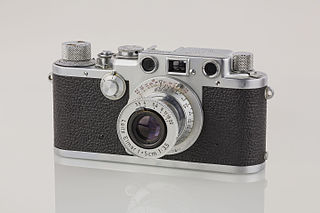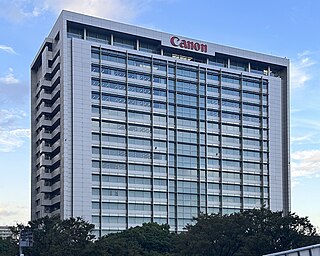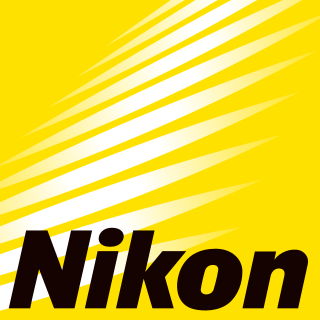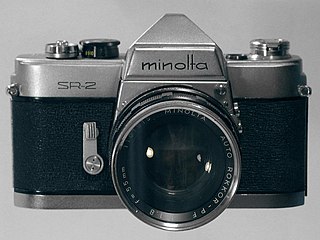
A camera is an instrument used to capture and store images and videos, either digitally via an electronic image sensor, or chemically via a light-sensitive material such as photographic film. As a pivotal technology in the fields of photography and videography, cameras have played a significant role in the progression of visual arts, media, entertainment, surveillance, and scientific research. The invention of the camera dates back to the 19th century and has since evolved with advancements in technology, leading to a vast array of types and models in the 21st century.

Leica Camera AG is a German company that manufactures cameras, optical lenses, photographic lenses, binoculars, and rifle scopes. The company was founded by Ernst Leitz in 1869, in Wetzlar, Germany. The name Leica is derived from the first three letters of the founder's surname (Leitz) and the first two of the word camera: lei-ca.

Canon Inc. is a Japanese multinational corporation headquartered in Ōta, Tokyo, specializing in optical, imaging, and industrial products, such as lenses, cameras, medical equipment, scanners, printers, and semiconductor manufacturing equipment.

Carl Zeiss AG, branded as ZEISS, is a German manufacturer of optical systems and optoelectronics, founded in Jena, Germany in 1846 by optician Carl Zeiss. Together with Ernst Abbe and Otto Schott he laid the foundation for today's multinational company. The current company emerged from a reunification of Carl Zeiss companies in East and West Germany with a consolidation phase in the 1990s. ZEISS is active in four business segments with approximately equal revenue in almost 50 countries, has 30 production sites and around 25 development sites worldwide.

A slide projector is an optical device for projecting enlarged images of photographic slides onto a screen. Many projectors have mechanical arrangements to show a series of slides loaded into a special tray sequentially.

Pentax Corporation was a Japanese camera and optical equipment manufacturer. Currently, it exists as the Pentax Life Care Business Division of Hoya's medical endoscope business, as well as the digital camera brand of Ricoh Imaging, a subsidiary of Ricoh.

Minolta Co., Ltd. was a Japanese manufacturer of cameras, camera accessories, photocopiers, fax machines, and laser printers. Minolta Co., Ltd., which is also known simply as Minolta, was founded in Osaka, Japan, in 1928 as Nichi-Doku Shashinki Shōten. It made the first integrated autofocus 35 mm SLR camera system. In 1931, the company adopted its final name, an acronym for "Mechanism, Instruments, Optics, and Lenses by Tashima".
Konica was a Japanese manufacturer of, among other products, film, film cameras, camera accessories, photographic and photo-processing equipment, photocopiers, fax machines and laser printers, founded in 1873. The company merged with Japanese peer Minolta in 2003, forming Konica Minolta.

Mamiya Digital Imaging Co., Ltd. is a Japanese company that manufactures high-end cameras and other related photographic and optical equipment. With headquarters in Tokyo, it has two manufacturing plants and a workforce of over 200 people. The company was founded in May 1940 by camera designer Seiichi Mamiya and financial backer Tsunejiro Sugawara.

Nikon Corporation is a Japanese optics and photographic equipment manufacturer. Nikon's products include cameras, camera lenses, binoculars, microscopes, ophthalmic lenses, measurement instruments, rifle scopes, spotting scopes, and equipment related to semiconductor fabrication, such as steppers used in the photolithography steps of such manufacturing. Nikon is the world's second largest manufacturer of such equipment.

Braun GmbH is a German consumer products company founded in 1921 and based in Kronberg im Taunus. The company is known for its design aesthetic from the 1960s through the 1980s, which included products such as electric shavers, radiograms and record players, movie cameras, slide projectors, clocks, and small kitchen appliances for which "Braun became shorthand for reliable, no-nonsense modernist goods."

Rollei was a German manufacturer of optical instruments founded in 1920 by Paul Franke and Reinhold Heidecke in Braunschweig, Lower Saxony, and maker of the Rolleiflex and Rolleicord series of cameras. Later products included specialty and nostalgic type films for the photo hobbyist market.

Contax began as a German camera model in the Zeiss Ikon line in 1932, and later became a brand name. The early cameras were among the finest in the world, typically featuring high quality Zeiss interchangeable lenses. The final products under the Contax name were a line of 35 mm, medium format, and digital cameras engineered and manufactured by Japanese multinational Kyocera, and featuring modern Zeiss optics. In 2005, Kyocera announced that it would no longer produce Contax cameras. The rights to the brand are currently part of Carl Zeiss AG, but no Contax cameras are currently in production, and the brand is considered dormant.

Retina was the brand-name of a long-running series of German-built Kodak 35mm cameras, produced from 1934 until 1969. Kodak Retina cameras were manufactured in Stuttgart-Wangen by the Kodak AG Dr. Nagel Werk which Kodak had acquired in December 1931.

Yashica Co., Ltd. was a Japanese manufacturer of cameras, lenses, and film editing equipment active from 1949 until 2005 when its then-owner, Kyocera, ceased production. It acquired the lens manufacturer Tomioka.

Pentacon is the company name of a camera manufacturer in Dresden, Germany.

Wirgin was a German company which is still known for its brands Wirgin and Edixa, and for its camera types like the Edina, the Edinex or the Gewirette. It was based in the Hessian capital Wiesbaden and made a line of quite inexpensive 35mm SLRs from the 1950s to the 1970s, including the Edixa Reflex and Edixa-Mat Reflex. Wirgin was West Germany's main producer of SLRs with focal plane shutter. It also produced some of the lenses for its cameras, among them several M42 screw mount lenses.

The Minolta SR-2 was presented in 1958 as the first 35mm SLR camera from Chiyoda Kogaku. Popular cameras of this type at that time were mainly from Europe but a few from Japan, including the Asahi Pentax, the Miranda T and the Topcon R. The miniature SLR camera concept was conceived in the 1930s at Ihagee in Dresden, resulting in the 1936 Kine Exakta. Influential cameras designs like that of the 1939 KW Praktiflex, the 1949 ZI Contax S, and 1952 the KW Praktina marked the steady progress toward a perfected SLR. Several features of the latter seem to have influenced the design of the SR-2 although dissimilar in many respects. The obvious similarities are the stepped top plate, the carrying strap lugs, the self-timer lever and some general body features.

Multi-image is the now largely obsolete practice and business of using 35mm slides (diapositives) projected by single or multiple slide projectors onto one or more screens in synchronization with an audio voice-over or music track. Multi-image productions are also known as multi-image slide presentations, slide shows and diaporamas and are a specific form of multimedia or audio-visual production.






















